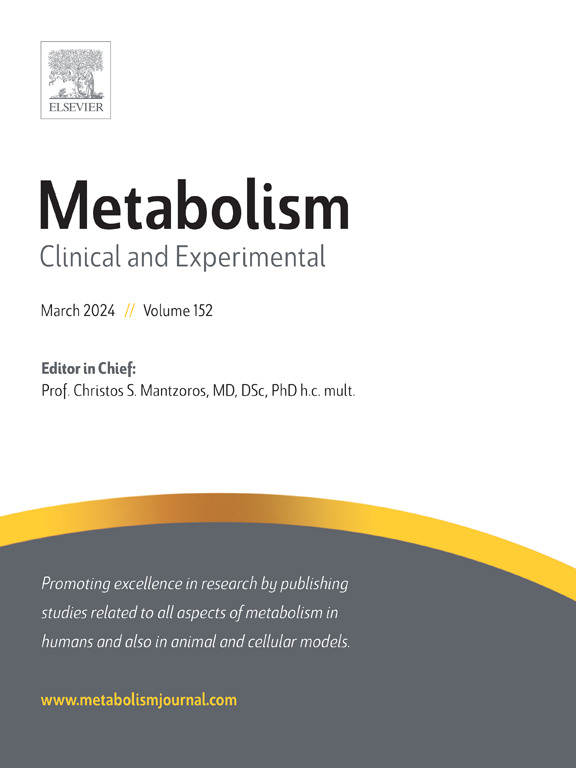Bilirubin bioconversion to urobilin in the gut-liver-kidney axis: A biomarker for insulin resistance in the Cardiovascular-Kidney-Metabolic (CKM) Syndrome
IF 10.8
1区 医学
Q1 ENDOCRINOLOGY & METABOLISM
引用次数: 0
Abstract
The rising rates of obesity worldwide have increased the incidence of cardiovascular disease (CVD), making it the number one cause of death. Higher plasma bilirubin levels have been shown to prevent metabolic dysfunction and CVD. However, reducing levels leads to deleterious outcomes, possibly due to reduced bilirubin half-life that escalates the production of its catabolized product, urobilinogen, produced by gut bacteria and naturally oxidized to urobilin. Recent findings suggest that the involvement of the microbiome catabolism of bilirubin to urobilin and its absorption via the hepatic portal vein contributes to CVD, suggesting a liver-gut axis involvement. We discuss the studies that demonstrate that urobilin is frequently raised in the urine of persons with CVD and its probable role in acquiring the disease. Urobilin is excreted from the kidneys into the urine and may serve as a biomarker for Cardiovascular-Kidney-Metabolic (CKM) Syndrome. We deliberate on the newly discovered bilirubin reductase (BilR) bacterial enzyme that produces urobilin. We discuss the bacterial species expressing BilR, how they impact CVD, and whether suppressing urobilin production and increasing bilirubin may provide new therapeutic strategies for CKM. Possible therapeutic mechanisms for achieving this goal are discussed.
肠道-肝脏-肾脏轴中胆红素向尿蛋白的生物转化:心血管-肾脏-代谢综合征(CKM)中胰岛素抵抗的生物标志物。
全球肥胖率的上升增加了心血管疾病(CVD)的发病率,使其成为头号死因。研究表明,较高的血浆胆红素水平可预防代谢功能障碍和心血管疾病。然而,降低胆红素水平会导致有害结果,这可能是由于胆红素半衰期缩短,使其分解产物尿胆红素原的生成量增加,尿胆红素原由肠道细菌产生并自然氧化为尿胆素。最近的研究结果表明,微生物组将胆红素分解为尿胆素,并通过肝门静脉吸收尿胆素,是导致心血管疾病的原因之一,这表明肝脏-肠道轴参与其中。我们讨论了证明心血管疾病患者尿液中尿蛋白经常升高的研究及其在患病过程中可能发挥的作用。尿蛋白从肾脏排泄到尿液中,可作为心血管-肾脏-代谢综合征(CKM)的生物标志物。我们讨论了新发现的产生尿胆素的胆红素还原酶(BilR)细菌酶。我们讨论了表达 BilR 的细菌种类、它们如何影响心血管疾病,以及抑制尿胆素生成和增加胆红素是否可能为 CKM 提供新的治疗策略。我们还讨论了实现这一目标的可能治疗机制。
本文章由计算机程序翻译,如有差异,请以英文原文为准。
求助全文
约1分钟内获得全文
求助全文
来源期刊

Metabolism: clinical and experimental
医学-内分泌学与代谢
CiteScore
18.90
自引率
3.10%
发文量
310
审稿时长
16 days
期刊介绍:
Metabolism upholds research excellence by disseminating high-quality original research, reviews, editorials, and commentaries covering all facets of human metabolism.
Consideration for publication in Metabolism extends to studies in humans, animal, and cellular models, with a particular emphasis on work demonstrating strong translational potential.
The journal addresses a range of topics, including:
- Energy Expenditure and Obesity
- Metabolic Syndrome, Prediabetes, and Diabetes
- Nutrition, Exercise, and the Environment
- Genetics and Genomics, Proteomics, and Metabolomics
- Carbohydrate, Lipid, and Protein Metabolism
- Endocrinology and Hypertension
- Mineral and Bone Metabolism
- Cardiovascular Diseases and Malignancies
- Inflammation in metabolism and immunometabolism
 求助内容:
求助内容: 应助结果提醒方式:
应助结果提醒方式:


